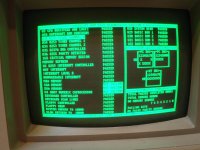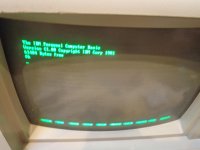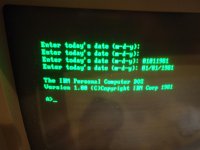The U26 (74LS175) readings:
pin 1: dead
pin 2: dead
pin 3: low
pin 4: dead
pin 5: dead
pin 6: low
pin 7: dead
pin 8: low
pin 9: pulsing (slow steady flashing/beeping on the logic probe)
pin 10: pulsing
pin 11: pulsing
pin 12: pulsing
pin 13: dead
pin 14: low
pin 15: dead
pin 16: dead
I have previously been advised that pin1 should be high. I am trying to figure out the schematics to probe upstream if necessary. These readings were taken with the Supersoft diagnostic ROM installed. Logic probe powered by +12v from power supply to floppy drive connector.
Have a look at the diagram [
here].
Pin 1 of U26 is an inverted reset signal.
At first power on of the PC, the PWR GOOD signal from the PSU is low, indicating that the PSU output voltages have yet to become suitable for use.
In that time (PWR GOOD signal low), the 8284 chip drives its output RESET line high, holding the motherboard in a reset state.
Pin 1 of U26 will be low (driven low by pin 2 of the U51 inverter).
When the PSU drives PWR GOOD high (i.e. output voltages now suitable for use), the 8284 chip drives its output RESET line low, releasing the reset state of the motherboard.
Pin 1 of U26 will be high (driven high by pin 2 of U51).
The above is totally independent of ROM code.
-------------------------------------------------------------------------------
A note about using the logic probe (or oscilloscope proble, whatever). In my experience, particularly with old circuit boards, oxide build-up on pins can cause voltage measuring problems. Many a time, I will have the probe pressed up hard against a pin, thinking, "that is enough force", but it turns that it isn't enough force to 'break through' the oxide layer. More pressure, and of of a sudden, a reading.
Could that be happening with your measurement of pin 1 ?



